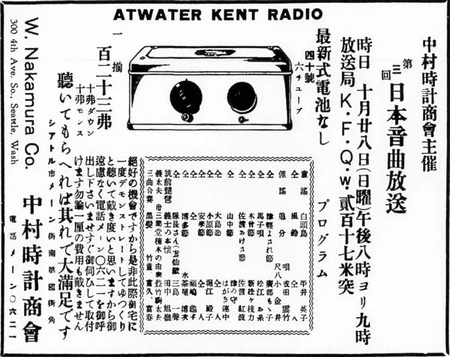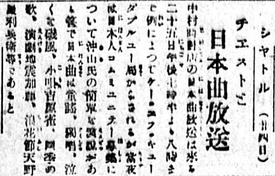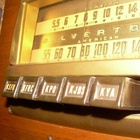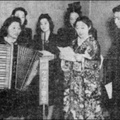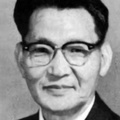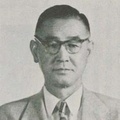Nakamura Watch Shop's Japanese Music Broadcast
While there were almost no regular Japanese radio programs in North America in the 1920s, "Japanese Music Broadcasting" began on Seattle's KFQW station on August 24, 1928. The Nakamura Watch Company, run by Nakamura Masakichi, a native of Fukui Prefecture, was the sponsor.
In addition to clocks, the store also sold radios and gramophones, and came up with the innovative idea of lending out radios free of charge for listening. The store promoted its service by saying, "We also play Japanese music for those who purchase a radio" (Daihoku Nippo, December 24, 1928 issue).
Japanese language newspapers carried advertisements for radio receivers, priced at over a hundred dollars each, along with program guides. This price was equivalent to a third-class round-trip fare to Japan at the time, and was far beyond the reach of ordinary people. Nevertheless, there was probably demand from the few wealthy people in the country.
This "Nihon Ongaku Hoso" can be divided into three periods based on the time slot. The first period ran from August 1928 until June 1929, and was a one-hour program that aired once a month from 8:00 pm. It is not clear whether announcements in Japanese were made during the program.
As the name "Japanese Music Broadcast" suggests, the program played records sent from Japan, and the first program featured a Japanese-Western ensemble "Kanda Jocho," a children's song "Nanking Dialect," "Takamine Biwa Sanraku Sou Sugoroku Uta," and a folk song "Akita Obako Bushi." At one point, 17 songs were listed, and it gives the impression that records of about 3 minutes each were played over and over again. In November, the broadcasting station was changed to KPQ.
In 1930, the show was broadcast for the second time at 7:30 pm on its old home station KFQW, shortened to 30 minutes, and eventually became a regular program aired every other Thursday. Each episode aired 5-7 records. A notable feature was that the first track was always a children's song sung by Hirai Eiko and others.
Also, local broadcasts offered stories that were interesting only if you could hear the content, such as rakugo "Kusame Kodan" (Shofutei Shokaku), "Kenka Nagaya" (Yanagiya Kingoro), Naniwabushi "Koganei Kojiro Shouho" (Kimura Tomoe), Nagauta "Kanjincho" (Yoshimura Ijuro), and Chikuzen Biwa "Sado no Wakatake" (Tanaka Kyokurei). These were likely also broadcast in response to requests from listeners.
On September 25th, in cooperation with the Japanese Community Chest, the broadcast was extended by 10 minutes, and Eishige Okiyama (President of the Japanese Association of North America Chamber of Commerce) explained their fundraising activities, showing that the station also played a role as an information agency for the Japanese community. The second period continued until April 1931.
The third season began on May 26, 1931, when the show began broadcasting on KXA, and in June it became a 30-minute program airing every other Friday at 7:00 pm. The show's content remained the same, being a music program focusing on records.
The previews show songs with fun-sounding titles such as the revue song "Sakura on Parade" (Fujimoto Fumiyoshi), the movie song "The Kankanmushi Sing" (Fujimoto Fumiyoshi), the popular song "Because I'm Lonely" (Kawahara Kikue), "Nikkatsu Actors Band Nonsense" (Nikkatsu Actors Band), and the popular song "Imi Fukabushi" (Amano Kikuyo). Of course, entertainment such as rakugo, manzai, and naniwabushi were also broadcast without fail.
The program previews published in the Daihoku Nippo newspaper show that this third period featured live performances, mainly from local Japanese musicians. On these days, the programs featured koto-shakuhachi ensemble (Hattori Shihan and Toba Shihan), sankyoku ensemble (Tanaka Torano, Nakajima Tsuruno, Oya Takekaze), Chikuzen biwa (Ota Shihan of Asahibikai), tanba and popular songs (Minato Ikko), and tenor soloist (Kamide Masataka). The six-month contract with KXA expired, and November 27, 1931 was probably the last broadcast.
Japanese Evening
"A Night in Japan" began on January 24, 1929 on KOMO station. It was broadcast every Thursday (Friday from February), with the first episode at 9:30 pm, and from 9:00 pm onwards, for 30 minutes. Unlike Nakamura Watch Shop's record broadcast, this program featured live performances by local musicians, and gained popularity. The first day's program featured a performance by harmonica virtuoso Sato Tokitaro.
On February 22nd, Master Hattori played shakuhachi and Ochiyo, a former geisha from Manekitei, played songs such as "Harusame," "Goshoguruma," "Kyo no Shiki," "Sazanami," and "Gichon-chon." Manekitei gained popularity for its Kansai cuisine and Osaka-style service, and is still in business today as Maneki in Seattle's Japantown. It is common for Japanese restaurants like Ochiyo, and geisha from local Japantown restaurants, to appear on radio shows to show off their skills, as is the case with Japanese radio shows across the West Coast.
On March 1st, the Japan Society organized a program featuring second-generation Japanese, including a violin performance by the Katayama sisters, an English speech by Uematsu, a student at the University of Washington who won a prize in a debate competition, and a jazz solo by Takayoshi, a student living in the U.S. The Japan Society received letters from Americans praising Takayoshi's vocals, saying they had never heard such a beautiful voice before.
March 8th was a special episode on Japanese music, featuring Fukuko Nakatani, a teacher of Hatsune-kai, a group that teaches Japanese dance and music in Seattle, and other guests, who performed on the shamisen and drums. This was the last broadcast of "Japanese Evening."
By the way, an American newspaper carried an interesting article about "Japanese Evening." One day, after the first song had finished and just before the second song was about to begin, a shamisen string broke. In order to buy time to replace the string, the American announcer had to talk about Japanese musical instruments and the weather, touch on upcoming program topics, and even ask for a bit of piano playing, and was forced to do some unplanned ad-lib. The article describes how the American announcer had a hard time. Thus, the announcer concluded that "Japanese Evening" was not suited to radio announcers. It seems that the job of announcers at that time was to accurately read a prepared script.
In the next issue , we will look at the early 1930s, when companies such as Miwado, Furuya Shoten, and the Daihoku Nippo newspaper all entered the radio broadcasting market.
*This article is an excerpt from Japan Hour (2020) and reprinted from North American Newspaper (December 22, 2021).
© 2020 Tetsuya Hirahara


